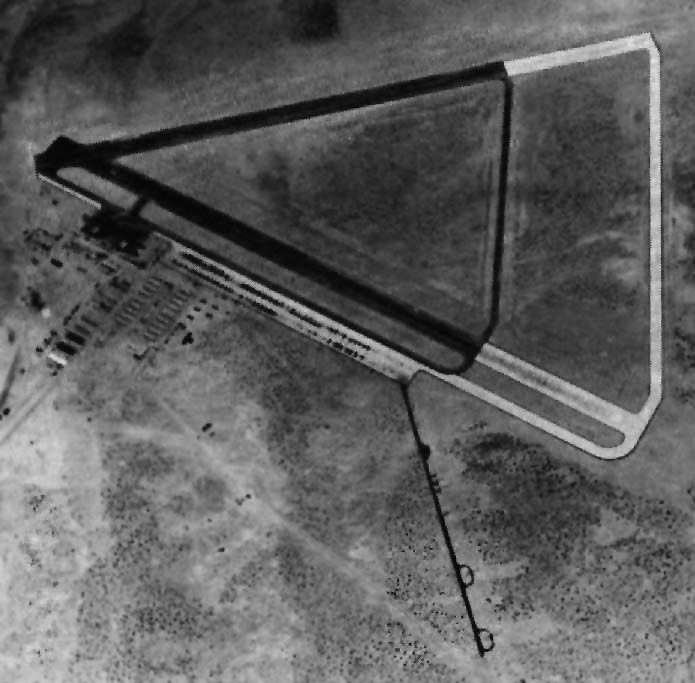

Holtville is located in California's Imperial Valley, 115 miles east of San Diego on the Mexican border. In 1942, the Navy purchased 1397 acres in the desert, eight miles east of town, for an auxiliary air station. Construction began in January 1943 and the flag was run up the flagpole on July 4, officially commissioning the station under the command of Naval Air Center San Diego.
The first squadrons arrived thirteen days later supported by a detachment of San Diego's CASU 5. The flying weather at Holtville was outstanding with VFR conditions 360 days a year. The nearby desolate mountains and desert provided ample gunnery and bombing ranges. The Salton Sea also provided skip-bombing ranges. Despite the remote location, the base was considered to be well appointed and comfortable. On the downside, summer temperatures averaging over 100 degrees F. made daytime flying operations very difficult -- for aircrews, as well as ground crews servicing the aircraft. During 1943, the station suffered nine fatalities.
Many changes occurred at Holtville during 1944. In February, two ground training buildings were completed that housed Link trainers and a Gunairstructor. Initially, the base hosted VC squadrons and up to late 1944 a total of 45 such squadrons had spent several months at the base for operational training. In May 1944, an expansion project increased the station's capacity from three to six squadrons. The only blimp to pay Holtville a visit, K-29, passed through on July 2. CASU 53 commissioned out of CASU 5 in August as the station became primarily a rocket training base. CAG 98, the replacement training air group, also had a contingent at Holtville. During all of 1944, 11 lives were lost in flight accidents.
In March 1945, an adjustment was made by all personnel as the first group of Waves arrived. During the year, 53 aviation units were hosted for an average of a one month stay with five fatalities. Beginning in December 1945, Holtville served as the short-time storage site for 111 PV-2 Privateers. The last of the PV-2s departed in April 1946 and the station went into caretaker status.
Initially, Holtville had two 4,500 x 200-ft. concrete runways that were later extended to 6,000 ft. Eight miles east of the station in the desert was the Sand Hill OLF with a catapult and arresting system, also used by the Marines from El Centro. In March 1944, complement stood at 330 officers and 2650 enlisted men with barracks for 175 officers and 1020 men. Station aircraft consisted of a Staggerwing Beech light transport, an AE Piper ambulance plane, and a Stearman. Holtville also provided supply and personnel support for the small NAAS on Salton Sea, 40 miles away.
Following the war, the Navy eventually gave the airport to the local community. For a time, the former base was used as a tuberculosis sanitarium. The airport has remained open, but sees very little activity. The Navy from El Centro occasionally uses the airfield for touch and go landings. The British Army parachute team has practiced here as well. No Navy built structures have survived.
Copied with the permission of the author from United States Naval Air Stations of World War II.
History by the US Army Corps of Engineers Los Angeles District (1999)
The Naval Auxiliary Air Station is located in Imperial County, CA, approximately 6 miles east of the Town of Holtville.
The Navy was granted permission in 1943 by the Department of Interior to use 2080 acres of public land near Holtville. The Navy actually used only 1248.99 acres and constructed the Holtville Naval Auxiliary Air Station, which was completed in June 1943. The mission of the facility was pilot training and specialized in night flying training. The instruction schedule included training in dive bombing, skip bombing, low-level bombing, target strafing, and carrier landings. Later, trainees also practiced rocket firing. Most of these activities took place at off-site locations. Improvements to the facility included paved runways and taxiways, hangars, ordnance storage, water treatment and sewage disposal systems, fuel farm and approximately 90 buildings used for administrative, shop, operation, recreation, barracks, mess and service functions. The Government disposed of 278.30 acres to the County of Imperial for use as a tuberculosis hospital. A portion of this parcel is now owned by the County of Imperial as part of an airport and the rest is privately owned with no specific use. A 791.76 acre parcel was disposed to the County for use as an airport. It still serves this purpose but gets very little use. The remaining 178.93 was retained by the Department of Interior and is still in their possession.
All Navy improvements except the fuel farm tanks were beneficially used after Department of Defense disposal. All building structures have since been removed. The water treatment and sewage disposal systems still exist but have not been operational since the hospital closed in the 1960s. The runway and taxiways have been beneficially used for commercial and private airplanes and car racing.
Extract, US Army Air Forces Directory of Airfields (January 2015)
.jpg)
Additional History: